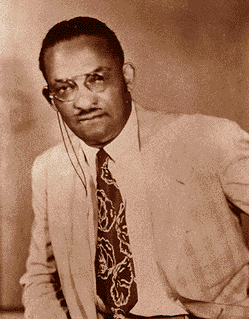Ossian Sweet
African-American physician and civil rights activist
Ossian Sweet (October 30, 1895 – March 20, 1960) was an African-American physician and civil rights activist in Detroit, Michigan. He is best known for his involvement in a self-defense case in 1925, which became a landmark in the fight against racial segregation and discrimination in the United States.
Early Life[edit | edit source]
Ossian Sweet was born in Bartow, Florida, to Henry Sweet and Dora Devaughn Sweet. He grew up in a time of intense racial segregation and violence in the Southern United States. Determined to escape the oppressive conditions of the South, Sweet pursued higher education, eventually earning a medical degree from Howard University in Washington, D.C..
Career[edit | edit source]
After completing his education, Sweet moved to Detroit, Michigan, where he established a successful medical practice. Detroit, like many northern cities, was experiencing significant racial tensions due to the Great Migration, during which many African Americans moved from the South to the North in search of better opportunities.
The Sweet Trials[edit | edit source]
In 1925, Sweet purchased a house in a predominantly white neighborhood in Detroit. This act of defiance against racial segregation led to violent backlash from white residents. On September 9, 1925, a mob gathered outside Sweet's home, throwing stones and threatening violence. In response, Sweet and his friends armed themselves to protect the property. Shots were fired, resulting in the death of one white man and the injury of another.
Sweet and ten others were arrested and charged with murder. The case, known as the Sweet Trials, drew national attention. Sweet was defended by the renowned attorney Clarence Darrow, who argued that Sweet had the right to defend his home and family against the mob. The first trial ended in a hung jury, and in the second trial, Sweet and his co-defendants were acquitted.
Later Life and Legacy[edit | edit source]
After the trials, Sweet continued his medical practice but faced ongoing harassment and financial difficulties. His wife, Gladys Mitchell, died in 1926, and Sweet struggled with depression. He remarried in 1928 but continued to face personal and professional challenges. Sweet's story remains a powerful symbol of the fight against racial injustice and the right to self-defense.
See Also[edit | edit source]
- Civil rights movement
- Clarence Darrow
- Great Migration (African American)
- Racial segregation in the United States
- Detroit
Related Pages[edit | edit source]
Search WikiMD
Ad.Tired of being Overweight? Try W8MD's physician weight loss program.
Semaglutide (Ozempic / Wegovy and Tirzepatide (Mounjaro / Zepbound) available.
Advertise on WikiMD
|
WikiMD's Wellness Encyclopedia |
| Let Food Be Thy Medicine Medicine Thy Food - Hippocrates |
Translate this page: - East Asian
中文,
日本,
한국어,
South Asian
हिन्दी,
தமிழ்,
తెలుగు,
Urdu,
ಕನ್ನಡ,
Southeast Asian
Indonesian,
Vietnamese,
Thai,
မြန်မာဘာသာ,
বাংলা
European
español,
Deutsch,
français,
Greek,
português do Brasil,
polski,
română,
русский,
Nederlands,
norsk,
svenska,
suomi,
Italian
Middle Eastern & African
عربى,
Turkish,
Persian,
Hebrew,
Afrikaans,
isiZulu,
Kiswahili,
Other
Bulgarian,
Hungarian,
Czech,
Swedish,
മലയാളം,
मराठी,
ਪੰਜਾਬੀ,
ગુજરાતી,
Portuguese,
Ukrainian
Medical Disclaimer: WikiMD is not a substitute for professional medical advice. The information on WikiMD is provided as an information resource only, may be incorrect, outdated or misleading, and is not to be used or relied on for any diagnostic or treatment purposes. Please consult your health care provider before making any healthcare decisions or for guidance about a specific medical condition. WikiMD expressly disclaims responsibility, and shall have no liability, for any damages, loss, injury, or liability whatsoever suffered as a result of your reliance on the information contained in this site. By visiting this site you agree to the foregoing terms and conditions, which may from time to time be changed or supplemented by WikiMD. If you do not agree to the foregoing terms and conditions, you should not enter or use this site. See full disclaimer.
Credits:Most images are courtesy of Wikimedia commons, and templates Wikipedia, licensed under CC BY SA or similar.
Contributors: Prab R. Tumpati, MD

